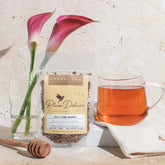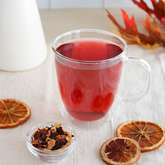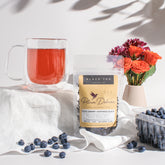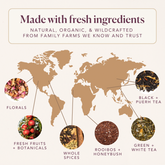Tamales are, for many families, a special holiday treat. Growing up, tamale night with my extended family was a much-anticipated part of the Christmas season. Gather a party of your favorite loved ones and make a batch of these sweet tea-males, inspired by the cinnamon-raisin dessert tamales of my youth.


Make it a Party!
I’ll be honest: tamales are a lot of work.
But the results are worth the effort!
And when you’re sharing the job with your favorite people, work isn’t really work anyway. You wile away the time talking, laughing, maybe drinking your favorite tea. (In my family it was always white wine and cervezas, but this is a tea-male party, after all.)
Choose a beverage, roll up your sleeves, and get ready for some food-based fun!
How to Make Dessert Tamales
Tamales are usually made in large batches, but the recipe is easy to scale up or down depending on how many people you’re feeding. We always had twenty people or more, so we went for volume!
In a group that large, someone was always on masa duty, mixing and kneading dough to be spread over the corn husks, or hojas. Two or three people were on meat duty, making sure it was properly seasoned, then overseeing the filling and folding of the tamales as the batches of prepared hojas were delivered to the kitchen.
The majority of people were on spreading duty—coating each hoja with a thin layer of masa using whatever spreading implement they could get their hands on: butter knives, spatulas, backs of spoons…there were a lot of us, so we got creative.
Inevitably, the meat would run out well before the masa did, and when that time came, my great-grandma would take all the remaining hojas and sprinkle them with cinnamon, raisins, and sugar—the height of decadence when you’re five and still delicious as an adult. Those sweet tamales, which she called dummies, or tontos, are what these tea-males are based on.
How to Fill a Tamale
You’re probably familiar with meat-based tamales. Chicken, pork, shredded beef…
I never say no to a good meaty tamale, but today, we’re focusing on sweeter tamales.
The tontos of my childhood were pretty exclusively cinnamon raisin tamales, but I’ve since learned that sweet tamales are popular street food in Mexico. You can walk down the street feasting on tamales stuffed with strawberry, pineapple, dulce de leche, and more…
For those of us making tea-males at home, any one of those choices is an awesome starting point, and from there, let your imagination run wild! In the future, I’d love to experiment with toasted coconut, caramelized bananas, spiced nuts, Nutella… It’s a whole new world, and I plan to fill it with tamales.
Once you’ve decided on your filling of choice, the next step is prepping your hojas.
While you assemble your masa and filling, soak your hojas in warm water. This step cannot be skipped, or your corn husks won’t be flexible enough to fold.
Once your hojas are soaking, prepare your masa and get ready to spread!
In my family, there are very strict guidelines for spreading masa onto an hoja. My great-grandma’s rules were as follows:
- Masa should not be too thick or too thin
- Masa should start approximately 2/3 of the way up the hoja and be spread all the way to the bottom (the widest part of the hoja)
- Masa is ALWAYS spread on the smoothest side of the hoja
- When you lift up the hoja, the masa should be thin enough that you can see light through some parts of the masa (no holes, though…just thin spots.)
Here are a few tips to keep in mind:
On any hoja, there is a bumpy side and a smooth(ish) side. Some are very easy to tell apart, and some try to trick you. I like to run my fingernails along both sides of each hoja I pick up. The side that rakes across my fingernails the most is the side I put flat down on the table. The other side is spread with masa.
If your masa is a quarter-inch thick or more, it’s definitely too thick! Shoot for an eighth of an inch or less.
The pointiest part of the hoja is the top. Masa is spread downward toward the widest part of the hoja.
Assembling Your Tamales
In my research, I’ve found that you can mix your raisins or other sweet add-ins directly into your masa, then simply plop a healthy portion of the mixture right in the middle of the husk without bothering to spread it thin.
Since my family only made tontos when we had run out of meat but still had prepared hojas coming out of our ears, we never used the plop method. All our hojas were already spread with masa, so my great-grandma would fill them with sweeter ingredients so they didn’t go to waste. (And to make an extra special treat for us kids…)
You can use the plop method if you like—it certainly saves time—though I found I prefer the shape and texture of the spread-and-fill method. (That might just be childhood nostalgia talking, though. Tamales are delicious, no matter what.)
Tamale-making should, in my opinion, be a celebratory experience shared with friends and family. The final result tastes all the better for the laborious process and time spent creating them together. It’s a labor of love—and love, we all know, is the secret ingredient to any dish.
Whether you use the plop method or the spread-and-fill method, when it comes time to fold your tea-males, the process is the same:
- Fold vertically one-third of the hoja toward the middle
- Fold the other two-thirds into the middle to cover the first third
- Fold the pointy end down horizontally to close the tamal
At that point, the tamales are ready to be steamed.
For steaming, I like to employ the campfire method. (That’s what I call it, anyway.) Prop two tamales against each other in the center of your steamer like a lean-to. Prop two more in the opposite direction so the four form a little tent. Build your remaining tamales out in a ring around that center until your pot is filled.
Let them steam, and an hour later, you’re ready to eat!

What is a Tea-Male?
As far as I’m concerned, a tea-male is any tamale you make using tea. There are a few ways this can be done.
- Tea in your masa
- Tea in your filling
- Tea in your steamer
You can use any or all of these methods!
One of the easiest and most delicious ways is to use tea-soaked raisins. Anywhere from an hour to the night before you assemble your tea-males, soak your raisins in your tea of choice.
A sturdy black tea is a wonderful pairing here but follow your heart. I’m a big fan of a classic Earl Grey, a spicy chai, or a simple vanilla black tea. The flavors complement beautifully without overpowering.
Using tea in your masa is also a perfect option because you want your liquid to be, as my grandma used to say, “more than hot.” The hottest liquid you can stand to touch is ideal for your masa. (Incidentally, the same rule goes for tortillas.)
Tea-based masa is a fun way to customize the subtle flavors in the dough to compliment your filling.
For a strawberry filling, consider a strawberry Earl Grey or a Strawberry herbal. For a pineapple filling, try Pineapple Pop or Peach Bellini herbal tea!
Chocolate hazelnut dessert tea would be the perfect pairing for a Nutella tamale. Soul Warmer herbal tea or Toasted Nut Brulee Oolong would be delicious with…well, anything, really, but you can’t go wrong with a roasted almond, hazelnut, or pecan.
If you use tea in your masa, you can always brew up a large pot and use whatever is left to fill the bottom of your steaming pot. (Or throw in your leftover tea leaves to flavor the water.)
And just like that, your delicious sweet tamales become delicious tea-males!
If you make these at home, we’d love to hear about it! Take a picture with your whole party and let us know what teas and fillings you use—tag us on Instagram: @plumdeluxe.
Happy cooking and happy eating, friends!

Cinnamon Raisin Tea-Males
- 3 cups Masa Harina (or fresh-ground masa, if it is available to you at a local Mexican market.)
- 3 cups tea of choice, freshly brewed and cooled just enough to handle
- 2 tablespoons shortening, melted *
- 1/2 – 1 teaspoon cinnamon, to taste
- 1/4 cup brown sugar
- 1/2 teaspoon baking powder
- Pinch of salt
*lard is the traditional fat used in tamales, and I highly recommend it for proper flavoring in meat tamales. For sweeter tamales, however, the pork flavor can be overwhelming. Shortening is a great option, but you can also try your luck with other fats like butter or coconut oil.
Ingredients for Filling:
- 3 cups tea-soaked raisins (or filling of choice**)
- 1/4 - 1/2 teaspoon cinnamon, to taste
- 2 tablespoons brown sugar
**Options include other tea-soaked dried fruits like apricots, dates, or figs; coconut, nuts, strawberries, pineapple, Nutella, and dulce de leche. The tamales in the photographs are filled with 1 and 1/2 cup raisins, 3 ripe bananas, and 1 cup crushed pecans.
Other Ingredients:
*These are sold in packages in the Mexican section of most grocery stores, or at your local Mexican market. You don’t need to buy corn and shuck it!
Directions:
Soak your hojas in a large bowl. You may want to weigh them down with a heavy lid or pot, since they tend to float.
While your hojas soak, assemble your masa. In a large bowl, (or the bowl of a stand mixer***) combine your masa harina, baking powder, salt, brown sugar, and cinnamon. Mix in melted shortening. Add hot tea, and mix by hand to combine, then knead for several minutes. You will know your masa is ready to use when you can spread a small amount on the back of your hand and it coats your hand easily.
(If the masa rolls into itself rather than coating your hand, it has too much oil and will not spread properly on the hoja. You can add more masa harina and liquid, or try the plop method of filling your hojas.)
Prepare your filling by combining all ingredients in a bowl.
Remove your hojas from their soaking liquid and pat or shake dry to remove excess liquid.
Using a butter knife, spread a thin layer of masa onto the smooth side each hoja, starting two-thirds of the way up, and going down to the very bottom at the widest part of the hoja.
Spoon a tablespoon or so of filling into each prepared hoja.
Fold your tamales. Fold one-third vertically in toward the center. Fold the other two-thirds to cover the first. Fold the pointy end down horizontally to finish.
Steam your tamales. Fill a steamer pot with enough water or tea to steam for an hour, but be sure the liquid is not touching your tamales. In the center, lean two tamales against each other (like a lean-to.) From the opposite direction, prop two more tamales against the first two to form a little tent-shape. Using those four tamales as a base, continue to prop other tamales in a ring around the center until your pot is filled. (Do not stuff too full, or tamales may not steam properly.)
Steam for one hour. Let them rest for a few minutes to set before serving.
Serve, and enjoy!
***A stand mixer is not necessary for this recipe. Some people use them, and that definitely takes some of the elbow grease out of the masa preparation, but if you’re making a large batch of masa, you’re probably better off kneading it by hand. Anything over three cups of masa tends to be too much for a standard mixer (both in terms of volume and strain on the motor).
Yield: About 20 tamales—can easily be halved, doubled, or tripled, depending on size of your party.

![Holiday Tea Variety Pack [6-Pack Variety of Flavors]](http://www.plumdeluxe.com/cdn/shop/files/holidayTeaVarietyPack.png?v=1759777907&width=165)















